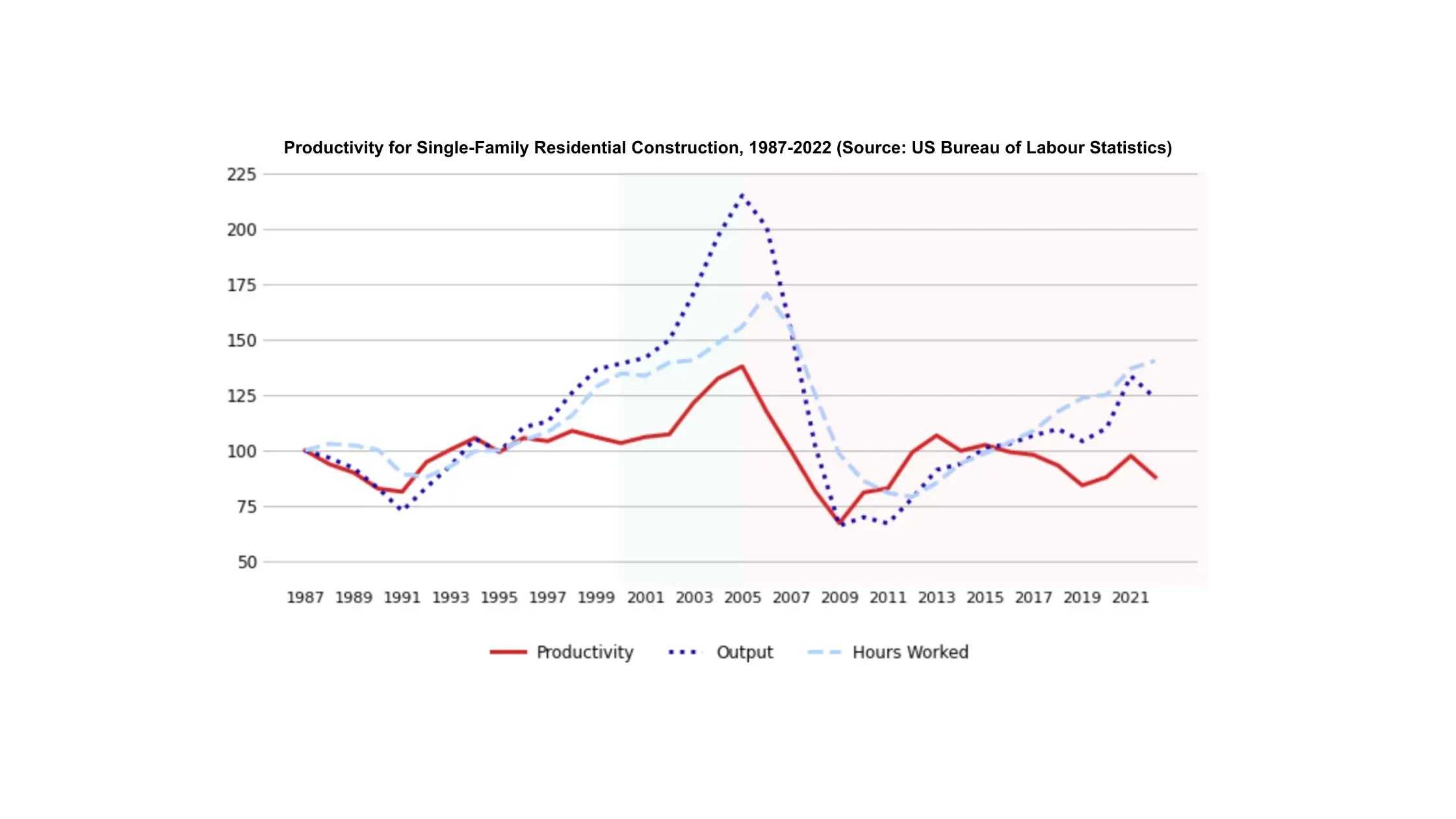I’ve talked to hundreds of construction project managers and learned that low productivity is often misunderstood. It's not just about apparent issues like workers not clocking in or tasks falling behind schedule—these are merely symptoms of a deeper problem.
The real issue lies in systemic factors like poor visibility into project progress, fragmented communication channels, skill gaps, and inefficient resource management. These challenges create a domino effect, where small inefficiencies snowball into significant delays and cost overruns.
So, to improve construction productivity, you must first determine your current productivity level, identify critical factors causing low productivity, and devise a strategy to reduce those causes.
In this article, I’ll provide the practical steps to overcome low productivity and the free project planning template we provide to construction project managers.
Below is a quick-navigation guide to each tip:
1. Measure the current productivity level
2. Correlate productivity levels with operational efficiency
3. Identify factors causing low productivity and efficiency
4. Adopt a flexible cost estimate system
5. Document change requests and adjust estimates instantly
6. Centralize data for consistent, data-driven decision-making
7. Keep stakeholders informed of progress and expectations
8. Address barriers to adopting smart building techniques
9. Adopt modern construction project management techniques
10. Provide clear and detailed instructions
11. Close critical skill gaps with training
12. Prioritize safety to prevent productivity losses
13. Get familiar with trends affecting construction productivity
1. Measure the current productivity level
Before devising a plan to improve productivity, assessing your team’s current productivity is essential. This means measuring the amount of work completed relative to the resources used—such as labor hours, materials, and equipment.
A simple calculation might look like this: if your team pours 100 cubic meters (3,531 cubic feet) of concrete in 10 labor hours, your productivity is 10 cubic meters (353 cubic feet) per labor hour. This metric helps gauge how efficiently resources are being utilized on the construction site.
Low productivity occurs when the work completed is less than expected compared to the resources consumed. For example, if the goal is to complete 20 square meters of foundation per day, but only 12 square meters are achieved, productivity is below expectations.
However, low productivity can manifest in different ways, and improvement in one area doesn't necessarily mean overall efficiency has improved. That's why it’s crucial to correlate productivity levels with operational efficiency to get a clearer, more comprehensive view.
2. Correlate productivity level and operational efficiency
While helpful, productivity metrics often provide a narrow view, focusing on individual tasks or events without fully considering the project's overall performance. This is where operational efficiency comes into play.
Operational efficiency assesses how effectively a project is completed in terms of cost, time, and quality. This means assessing the ratio between the output derived from the business and the input required to run business operations.

Consider a situation where the foundation work was completed, but due to rushing the job, errors occurred that required rework. Although the task was finished, the extra labor and materials needed for corrections increased the overall costs, and the project timeline was pushed back. This situation shows a case where productivity might appear acceptable, but operational efficiency is low.
To comprehensively improve productivity, you need to analyze both productivity levels and operational efficiency identifying whether the work being done is fast and practical in terms of cost and time. Here’s how:
- Step 1: Track productivity metrics regularly to monitor how much work is completed.
- Step 2: Analyze operational efficiency metrics to see if the project stays on budget and schedule.
- Step 3: Compare the two. If productivity is high but operational efficiency is low, it may indicate that speed is being prioritized over quality, leading to rework and delays.
- Step 4: Adjust your strategies to ensure productivity gains translate into overall project efficiency.
If your analysis shows that productivity and operational efficiency are declining, it’s time to identify the root causes. Are there communication breakdowns? Is there a lack of proper planning or oversight? Addressing these issues is the key to turning things around.
Let’s get into that in this next tip.
3. Identify factors causing low productivity and efficiency
Once you’ve correlated productivity with operational efficiency and noticed a decline in both, the next critical step is identifying the root causes. This process requires thoroughly examining various factors that might be contributing to the downturn. Here’s how you can approach it:
- Segment the data collected from your operational efficiency and productivity calculation into smaller, manageable parts, such as specific tasks, teams, or periods.
- Compare your findings against industry benchmarks or your historical performance data to understand whether the issues are isolated or widespread across the project or the entire company.
- Conduct surveys or interviews with team members to gather insights directly from those on the ground. Often, the people closest to the tasks can provide clues about inefficiencies that aren't immediately obvious from the data alone.
This process helps you review your workflow and identify process bottlenecks, such as how a delay or inefficiency in one area creates ripple effects that lead to widespread declines in both productivity and efficiency.
While the causes of low productivity in your company might differ from the next, these are some of the leading factors:
- Difficulty providing accuracy for construction tasks due to unforeseen circumstances.
- Failure to solidify agreement terms due to informal verbal change requests
- Poor reporting due to a lack of real-time information.
- Lack of awareness from the client regarding the cost impact of design choices.
- Difficulty measuring progress because some phases demand extended preparation with minimal visible advancement.
- Missing or inaccurate documentation causes financial and legal trouble due to a lack of efficient documentation process.
- Incomplete construction instructions.
- The lack of transparent communication and collaboration.
👉 Read the step-by-step guide on how to conquer the biggest challenges in construction [Free Access]
4. Adopt a flexible cost estimate system
Providing accuracy for construction tasks and costs is often challenging due to unforeseen weather conditions, supplier delays, and surprises.
When time spent on tasks exceeds estimates, it creates a dilemma for contractors – whether to invoice clients for the total amount, potentially leading to client dissatisfaction, or stick with the original estimate.
We often recommend using a construction estimate checklist that accounts for unforeseen circumstances as a solution. You can then add the checklist details to your agreement.
For example, the construction checklist provides a space for you and the client to note, comment, and agree on for review and adjustments. Additionally, you’ll get:
- Project planning and compliance checklists
- Site readiness and environmental considerations
- Financial, legal, and communicational checklists
- Top tips on pre-construction practices
👉 Get the free construction cost estimate template
5. Document change requests and adjust estimates instantly
You and I know that client requests for changes are inevitable in construction. Whether it’s a modification to the project scope, material adjustments, or timeline changes, these requests often occur on the fly.
However, when these changes are agreed upon verbally, they introduce significant risks. Critical details can easily be forgotten, misinterpreted, or overlooked entirely. This leads to misunderstandings and potential disputes over project scope, cost, and schedule and disrupts the workflow, causing delays and inefficiencies. These disruptions can quickly snowball into more significant issues, such as rework, extended project timelines, and strained client relationships—all clear signs of low productivity.
To prevent these issues and maintain high productivity, project managers must have a system that allows them to document change requests immediately as they are agreed upon and instantly adjust the project’s time and cost estimates to reflect the new terms.
By doing this, all modifications are accurately reflected in your project plan, helping you stay on track and within budget while maintaining transparency and clarity for all stakeholders.
6. Centralize data for consistent, data-driven decision-making
In many construction companies, data exists in silos, leading to inconsistent decision-making that is often ad hoc and team-dependent. According to a KPMG report, 31% of companies acknowledge that while data is available, its usage is fragmented and varies depending on the team or individual in charge.
When data is scattered across different departments or systems, it becomes challenging for project managers to make informed, timely decisions that improve project outcomes. For example, important metrics like material usage, labor costs, or equipment availability may not be readily accessible to the team, delaying critical project milestones or causing oversights that could have been avoided.
To run a smooth construction project, several critical data types must be easily accessible and centralized. These include:
- Project scheduling and timelines: Whether you’re tracking milestones, adjusting timelines, or coordinating teams, keeping this information centralized ensures the team works from the same playbook.
- Budget and financial data: Keeping track of costs, material expenses, labor rates, and overall project budgeting is critical to avoiding cost overruns. Inaccurate or incomplete financial data can lead to overspending, delayed payments, and disputes with clients, subcontractors, or suppliers.
- Material and resource inventory: Managing materials and resources in a construction project is essential for ensuring there are no delays due to stock shortages or over-ordering. Use a centralized inventory management system that tracks material availability, orders, and deliveries in real-time.
- Workforce and labor data: Inefficient allocation of labor can result in delayed tasks, increased costs, and safety risks. Consider workforce management tools to keep track of labor hours, productivity levels, and training.
- Compliance and safety records: OSHA incidents, permits, and safety training records should be available to project managers to ensure everyone on-site is certified and working in safe conditions. Some project management software solutions also offer safety modules to manage compliance more effectively.
Document management (blueprints, contracts, change orders): Fragmented document storage can lead to misplaced or outdated information, increasing the risk of errors and delays. Platforms like Buildbite consolidate all project-related documents in a single, accessible location.
Related: Best field management app: Top 5 picks in 2024
7. Keep stakeholders informed of progress and expectation
In construction, progress is often judged by visible signs:
- How much time has passed?
- What tasks have been completed?
- How close the current state is to the completed state?
However, this natural tendency to measure progress based on visible clues can sometimes be misleading, especially in phases without readily observable progress. For example, significant preparation work might happen behind the scenes, or specific tasks, like curing materials, require time without much visible change.
When progress is misjudged, clients can mount additional pressure on the project managers, who might overreact by adding more resources or speeding up tasks that don’t need acceleration. The pressure to show visible progress can strain team morale and lead to miscommunication with stakeholders, resulting in inefficiencies, errors, and rework, all of which reduce overall productivity.
Not all progress can be made visibly available. Project managers should anticipate phases where progress might not be noticeable and communicate this to stakeholders.
Use this checklist to ensure your schedules, cost estimates, project teams, and clients are all aligned before work commences on-site. 👉 Download the ultimate pre-construction checklist for building contractors
8. Address barriers to adopting smart building techniques
The construction industry is increasingly adopting smart building techniques to enhance productivity and safety on construction sites. These methods include advanced digital technologies, off-site manufacturing, and real-time data monitoring. However, several barriers hinder widespread implementation, particularly within project management processes.
Resistance to change and cultural barriers among employees and senior stakeholders is one of the most significant challenges. It severely impacts productivity by delaying the implementation of more efficient methods and increasing the complexity of project management.
For example, in cases where project managers must visit multiple sites physically, automated machine control could have significantly improved productivity and safety by continuously tracking workers, equipment, and materials.
Overcoming these barriers is key to improving productivity on construction sites. Consider the following strategies:
- Develop a cost-benefit analysis: Highlight the long-term savings and productivity gains from adopting smart technologies. Use this analysis to secure buy-in from stakeholders by presenting a clear return on investment.
- Invest in training: Ensure your team is well-prepared to use new technologies by offering workshops, hands-on training, or expert guidance. A well-trained team is crucial for smooth implementation and ongoing productivity.
- Plan for integration: Collaborate with IT and other departments to assess the compatibility of new technologies with existing systems before adoption. This proactive approach ensures that productivity gains are sustainable and that efficiency increases over time.
Addressing these barriers allows project managers to lead their teams in adopting smart building techniques, ultimately driving greater productivity and competitive advantage in the construction industry.
9. Adopt modern construction project management techniques
Construction project management has evolved to meet the increasing complexity of contemporary projects. This evolution marks a shift from traditional, manual processes to sophisticated, technology-driven methodologies influenced by the need for enhanced efficiency, precision, and accountability.
Despite these advancements, many construction projects still rely heavily on outdated methods. Estimates suggest that around 20-30% of projects are managed using traditional, non-technological approaches, particularly within smaller companies or teams resistant to change.
For instance, while Building Information Modeling (BIM) is increasingly adopted, studies indicate that up to 60% of construction firms may not fully utilize this technology, with only 28.8% having dedicated BIM departments. The consequence of clinging to outdated methods is often lower productivity and efficiency than competitors who embrace modern techniques.
Below are some modern techniques that construction project managers should consider integrating into their workflows:
- Advanced scheduling techniques: Utilize methods like Critical Path Analysis or Lean construction principles to optimize workflows, minimize downtime, and streamline project timelines.
- Adaptive management: Employ adaptive management techniques to handle construction projects' uncertainties and dynamic nature. This involves making decisions based on real-time project data and situational challenges, ensuring that projects remain on track despite unexpected changes and risk management remains uncompromised.
- Agile project management: Project managers can enhance flexibility and responsiveness in their projects by using practices such as maintaining a backlog, conducting sprints, and engaging cross-functional teams.
- Modern project delivery methods (PDM): Evolve with modern PDM that are digitally integrated, people-centered, and focused on sustainability. Leveraging AI-driven decision support models can help select each project's most appropriate delivery methods.
- Mathematical tools and techniques: Incorporate tools such as Bar Charts, Critical Path Method (CPM), and Program Evaluation and Review Technique (PERT) to manage complex project environments effectively.
- Modern technologies in project management: Advanced technologies like IoT devices can be used to track the location and condition of equipment and materials, improving inventory management and reducing losses.
- Advanced procurement methods: Use modern procurement strategies based on multi-attribute decision-making that considers risks, sustainability, and technological innovations to make informed decisions tailored to each project's needs.
Adopting these modern construction project management techniques is about keeping up with industry trends and staying competitive in a fast-paced environment.
10. Provide clear and detailed instruction
One common challenge on construction sites is the lack of clear instructions for workers to complete specific tasks. Without detailed guidance, workers may improvise, leading to slower progress, rework, or even costly construction errors.
And, in the event of a construction error, particularly one that leads to legal disputes, determining whether clear instructions were provided and followed is often central to establishing liability. Legal proceedings can be time-consuming, expensive, and stressful for all parties involved.
An effective construction workflow management software mitigates this risk by organizing tasks and phases. This allows you to assign tasks with specific, detailed instructions and documentation, such as work instructions or reference materials, which assigned workers can access.
For example, when instructions are uploaded to a task, the software can prompt workers to acknowledge that they have reviewed and understood the instructions before they begin. If the instructions are unclear or incomplete, workers can flag the issue for clarification, ensuring that no task proceeds without proper direction.
These systems reduce the likelihood of misunderstandings, improve accountability, and create a culture of precision and quality on construction sites.
👉Get the ultimate RFI construction template [Free Download]
11. Close critical skill gaps with training
Skill gaps on construction sites, particularly those related to modern construction processes, are a significant barrier to increased productivity and efficiency. These gaps are often exacerbated by the industry’s aging workforce, where critical knowledge and expertise are not being replenished quickly enough by younger generations.
In addition to an aging workforce, there is a marked decline in the number of young people entering the construction industry. For example, in 2021, only 713,000 apprentices were registered in the UK—the lowest figure since 2010—with nearly half failing to complete their programs. This shortage of new talent, combined with the lack of interest in construction careers among students (only 5% of whom consider the sector), creates a skills crisis that affects the ability to adopt new technologies and processes efficiently.
Project managers can be crucial in addressing this challenge by identifying critical skill gaps within their teams and implementing targeted training programs. For example, PMs should consider upskilling workers in digital construction tools, leveraging construction software with AI, data analysis, and modern building techniques. That way, companies can ensure that their teams are equipped to handle the complexities of modern construction projects, ultimately leading to improved productivity and project outcomes.
Interestingly, investing in ongoing training will not only fill the immediate skill gap, it also promote a culture of continuous learning, ensuring that workers remain adaptable and competitive in a rapidly evolving industry.
12. Prioritize safety to prevent productivity losses
The compounding effects of poor safety management can quickly erode productivity over time when accidents and injuries lead to time lost from work, delayed schedules, costly rework, and hefty fines. For instance, dislocation and inflammation injuries alone account for an average of 132 and 82 workdays lost per worker, respectively. What’s worse is that these accidents don’t just impact individual workers—they affect the entire project and, over time, significantly drain overall productivity.
So, as project managers, it’s best to think of safety incidents like an iceberg: the direct costs, such as medical expenses and compensation, are the visible tip. Beneath the surface lie the hidden costs, including lost workdays, equipment damage, project delays, poor morale, and increased insurance premiums, all of which can quietly but significantly reduce profitability.
Therefore, prioritizing safety isn’t just about compliance, but also sustaining long-term productivity and protecting the bottom line. Interestingly, studies show that companies that invest just 2.5% of project costs into safety training and protocols experience a 4-7% increase in profits per project. That’s because they avoid the cascading adverse effects of poor safety management on project timelines and costs.
13. Get familiar with trends affecting construction productivity
Staying informed about the latest trends in construction productivity is essential for any project manager looking to stay ahead of potential challenges. New technologies, innovative construction methods, and shifts in workforce dynamics are constantly reshaping the industry, and being familiar with these trends allows you to adapt faster, implement the latest tools or techniques, and position your projects for success.
Let’s look at some of the top construction productivity trends you must know in 2024.
Construction productivity trends you must know in 2024
1. BIM adoption is skyrocketing
Building Information Modeling (BIM) is seeing widespread adoption. Its impact on construction productivity cannot be overstated, and this cannot come at a better time. Currently, rework costs due to incorrect or faulty builds account for nearly 30% of construction industry expenses.
BIM helps mitigate this by enabling teams to create a detailed, virtual model of the entire project before construction begins. This model allows project managers, architects, and engineers to visualize every component, detect potential conflicts, and collaborate more effectively in real-time.
For you, BIM means fewer surprises on-site, smoother communication, and less rework, all of which lead to increased efficiency and reduced costs. The ability to foresee issues, prevent costly mistakes, and keep everyone aligned on the project plan will ultimately boost productivity and contribute to project success.
2. Construction management software (CMS) adoption
With the global CMS market expected to grow to $23.9 billion by 2031, the trend is clear: digital tools like CMS are here to stay, and embracing them will be key to staying competitive and enhancing overall productivity.
Traditionally, resistance to digitalization in construction has been driven by concerns such as unclear ROI, lack of prioritization, and insufficient in-house expertise. However, the increasing adoption of CMS signals a shift in mindset, as decision-makers become more receptive to technology. This presents an opportunity for project managers to leverage CMS not just for project efficiency but also to drive further technological innovation on-site.
3. The construction 3D printing market is growing
The construction 3D printing market is expanding at an astonishing rate, with a projected compound annual growth rate (CAGR) of 100.7% through 2030. This surge represents a significant opportunity for construction companies to boost productivity by harnessing 3D printing technology
One of the key benefits of 3D printing in construction is the significant time-savings it offers. For instance, California-based Mighty Buildings has demonstrated how 3D printing can streamline the construction process by reducing build times.
Unlike traditional construction methods, 3D printing automates various phases of the building process, speeding up project completion without sacrificing quality.
4. Smart hard hats promise a significant reduction of slip, trip, and fall hazards
We've already discussed how safety incidents have a cascading negative impact on productivity, with workers missing days of work due to injury and companies facing costly OSHA fines. Luckily, smart hard hats are emerging as a promising solution to significantly reduce slip, trip, and fall hazards on construction sites. They integrate sensors, GPS, and even augmented reality to provide immediate feedback to workers, ensuring they remain aware of hazards and improving overall site safety.
For project managers, adopting smart hard hats can not only improve safety but also minimize downtime caused by workplace injuries, reduce the likelihood of expensive legal battles, and avoid delays due to reassignments.
5. Drone technology reduces waste in construction projects
Drone technology is transforming construction by making processes more efficient and significantly reducing waste. The construction industry experiences around $160 billion in annual waste, but the use of drones has already contributed to cutting this down. For instance, using drones to measure stockpiles of building materials in real time has increased measurement accuracy by 61%, minimizing material mismanagement and reducing rework.
6. Labor shortage continues to delay construction projects
The labor shortage in construction is a growing concern and is expected to worsen. Currently, the industry would need to hire 650K additional workers on top of the normal hiring pace in 2022 to keep up with demand.
This shortage is severely impacting project timelines and completion rates, with 89% of construction firms reporting difficulties in filling positions, and 61% experiencing delays directly tied to the labor shortage.
As firms struggle to staff projects adequately, more pressure falls on existing workers, often resulting in fatigue and lower efficiency. To combat this, project managers must explore strategies such as upskilling current staff, investing in automation, and utilizing more off-site construction techniques to offset labor demands.
The role of field service management software in enhancing construction productivity
Field service management software, a subset of Construction Management Software, digitalizes the management of field operations required for a construction project—such as communication and collaboration, dispatching, task tracking, worker management, and equipment monitoring—in real-time. The key benefits include:
- Real-time job scheduling and dispatching.
- Enhanced communication and collaboration.
- Project documentation management.
- Resource and inventory management.
- Automated reporting and data capture.
Ready to boost productivity, check out our free trial, and discover exactly how you can pave the way to increased productivity for your construction business with Buildbite.




.jpg)




